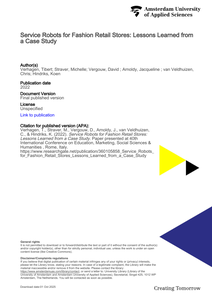Service robots provide retailers with new opportunities to innovate their in-store service offerings. Despite advances made in the fields of human-robot interaction, information systems, and marketing, there is relatively little known about how to apply a service robot in retailing. In this paper we aim to shed light on this issue by exploring the added value, roles, and prototyping of a service robot in fashion retailing. Using two Dutch fashion stores as real-life settings, we apply differentinteraction techniques (observation, interview, survey, structured role play, prototyping) to generate first insights and obtain lessons learned. The results of our study suggest that fashion retailers would benefit most from using service robots for communication of promotions and provision of product information. When applying service robots to these use cases, customers seem to prefer briefly and clearly expressed information that is communicated in a style that matches (in-)store communications. Still, the lack of personal attention and social support associated with a service robot makes retailers and store personnel rather reluctant to use them for their service excellence-oriented stores.
MULTIFILE

This article seeks to contribute to the literature on circular business model innovation in fashion retail. Our research question is which ‘model’—or combination of models—would be ideal as a business case crafting multiple value creation in small fashion retail. We focus on a qualitative, single in-depth case study—pop-up store KLEER—that we operated for a duration of three months in the Autumn of 2020. The shop served as a ‘testlab’ for action research to experiment with different business models around buying, swapping, and borrowing second-hand clothing. Adopting the Business Model Template (BMT) as a conceptual lens, we undertook a sensory ethnography which led to disclose three key strategies for circular business model innovation in fashion retail: Fashion-as-a-Service (F-a-a-S) instead of Product-as-a-Service (P-a-a-S) (1), Place-based value proposition (2) and Community as co-creator (3). Drawing on these findings, we reflect on ethnography in the context of a real pop-up store as methodological approach for business model experimentation. As a practical implication, we propose a tailor-made BMT for sustainable SME fashion retailers. Poldner K, Overdiek A, Evangelista A. Fashion-as-a-Service: Circular Business Model Innovation in Retail. Sustainability. 2022; 14(20):13273. https://doi.org/10.3390/su142013273
DOCUMENT

Local online retail platforms (LORPs) are gaining popularity as digital channels that can increase physical retail agglomerations’ attractiveness and viability by stimulating online sales and consumer footfall. However, insights are needed to enrich academic understanding and guide practitioners in their decision-making process regarding use and optimization of these platforms for boosting retail agglomeration vitality. Drawing on uses and gratifications theory, an online survey of 442 Dutch consumers revealed that positive attitudes toward browsing LORPs induced both online purchase and offline visit intentions. Interestingly, despite LORPs' local focus, non-place-specific motives more substantially impacted positive browsing-related attitudes toward LORPs than place-specific ones.
DOCUMENT

In “Van Pop-Up store naar local hero” doet de Haagse Hogeschool in samenwerking met de Gemeente Den Haag, Inretail en creatieve ondernemers onderzoek naar businessmodellen die pop-up stores van laatst genoemden, helpen doorgroeien naar levensvatbare ondernemingen. Traditionele businessmodellen voor de retail blijken weinig geschikt voor deze creatieve ondernemers. Zij hebben de Haagse Hogeschool gevraagd te onderzoeken wat wél werkt. Het onderzoek wordt daarom ingericht op basis van de vraag: “Welke bouwstenen van businessmodellen helpen creatieve ondernemers om een pop-up experiment tot een levensvatbare en lokaal onderscheidende onderneming te laten doorgroeien?” Het project wil aldus door inventarisatie en analyse van succes- en faalfactoren komen tot een geraamte van kritieke bouwstenen voor retail business modellen, die, afhankelijk van de aard van de creatieve ondernemer, op maat kunnen worden toegepast.